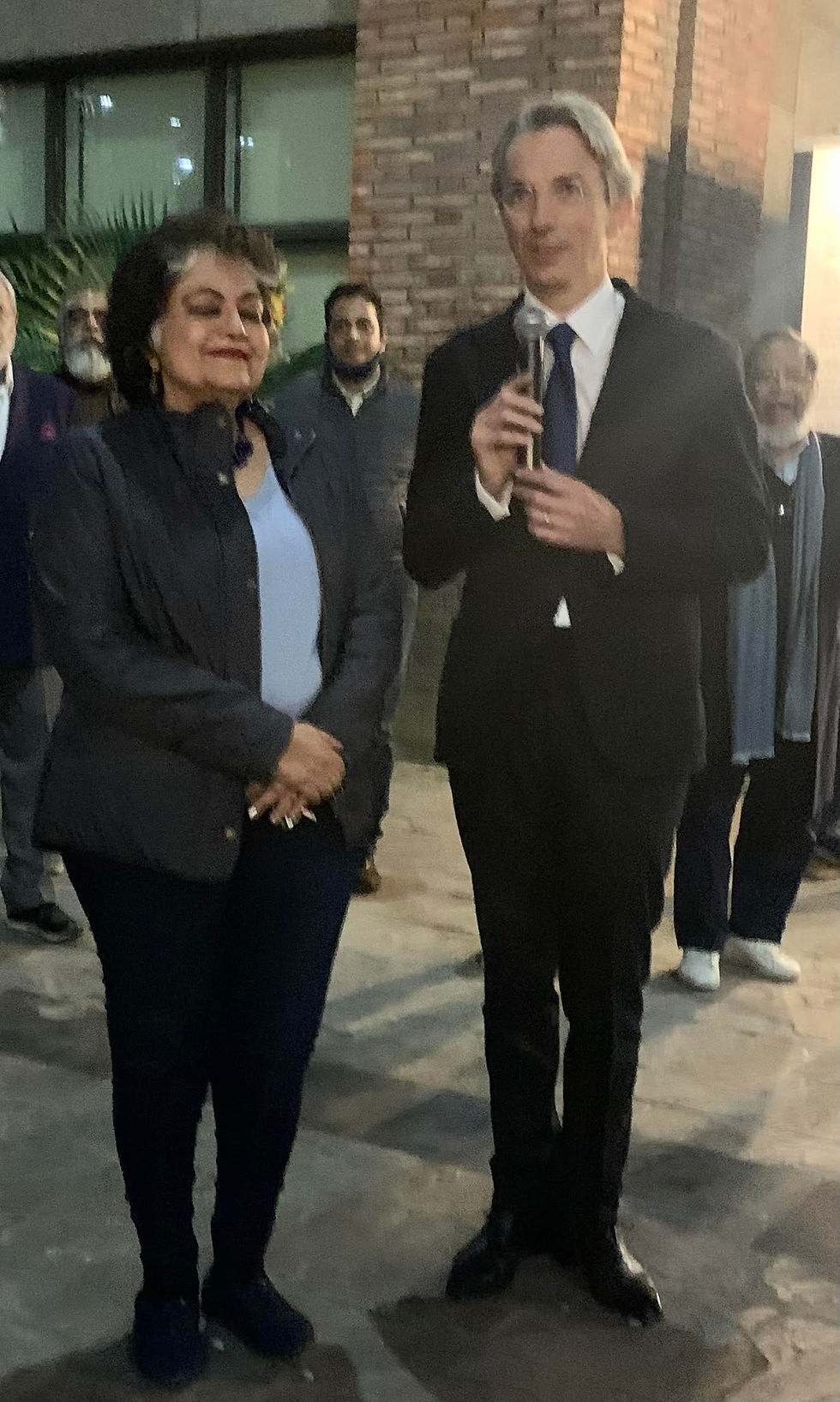by Ranjan Kaul
The open-to-the-sky exhibition space at the India Habitat Centre, New Delhi, with its surrounds of greens and buildings, provided the ideal ambience for the recently concluded month-long photographic exhibition of Emmanuel Lenain, the Ambassador of France to India, titled “Invisible Poetry”. The exhibition reflected his travels to an array of Indian cities over the past two years or so where he captured India’s culturally diverse ethos. Wearing his photographer’s hat, the French diplomat portrays a personal and deeply layered vision of India through 48 black-and-white photographs using a 35 mm Leica camera lens.
Lenain’s first photographic exhibition (2016) was a series on China held in Paris at Maison Européenne de la Photographie. In 2022, he and the well-known Indian photographer Raghu Rai jointly published Through Their Eyes: Raghu Rai and Emmanuel Lenain, featuring photographs he had taken in India and those shot by Raghu Rai in Paris.
Ranging from Bollywood posters and smiling children in festive attire to urinals and statues covered with cloth, Lenain’s photographs depict a unique aspect of India, capturing “the invisible poetry that lies within the most prosaic” to uncover “the structure of the country, the bones under the skin” as he describes it. Among the photographs on show are also shots of works made in the Faculty of Arts, MSU Baroda, including a sculpted portrait of a bearded man hung on a metal cage and beside it an agitated-looking nude sculpture.

Talking about Lenain’s work, Dr Alka Pande, the curator of the show, says, “Not one to take the well-trodden comfortable path, Lenain prefers the more challenging one. He plays with the medium, pushing the envelope in relation to both technique and creativity. He shies away from the exotic vision of India to the spell of which most visitors fall prey. He is of the firm belief that art emerges from constraints. Black-and-white was not an easy choice for Lenain to represent a country awash with fantastic colours. It creates an obligation to divide the often-pure forms that are hidden behind the noisy effervescence of the streets.”

Emmanuel Lenain with Dr Alka Pande at the opening
On his penchant for gelatine silver print photography and choice of subject matter, Lenain says, “India is a country that summons the sort of sensations the mind needs time to rationalize; and photography, recording the moving scene in static images whilst making way for gradual reconciliation of sentiment and thought, is the perfect instrument to do so . . . I have always preferred forms to colours, drawing to painting, Bach to Tchaikovsky.” He adds, “I never stage a situation and believe in the ability of photography to fix the decisive moment.”
Grouped under three thematic “chapters”, the first chapter in the exhibition, “The Invisible Structure of India” captures structures and patterns – from empty chairs in a cinema hall to clothes put out to dry, finding order, as it were, amidst the disarray, chaos and mixed sensations. The second chapter, “The Second Life of Objects” poses questions on the past and future of objects – a discarded concrete bench in a park, an abandoned bioscope with speakers mounted atop it, a ramshackle car. “Objects often acquire a life of their own, at times, intriguing, ominous, or grotesque,” says Lenain. In the concluding chapter, “Unnatural Landscapes”, are images such as a glass fence jutting out into the sea in Visakhapatnam and numbered logs of wood, an expansive park, evoking a sense of desolation and stillness, where the photographer also makes a strong comment on endangered nature.
Many of the photographs are devoid of human beings, and in instances when they do appear, they seem like intrusions, coming in the way of the order of things. Interestingly, however, a series of striking images of people reflect the religious and cultural diversity of the country – men and women taking a holy dip, a scene of Christian worship, two young women whirling in black attire.
Lenain’s images are not choreographed or staged. The photographer chooses to leave many things unsaid, allowing the images to speak for themselves and viewers to arrive at their own vision and interpretation. As one leaves the exhibition, there is an urge to return and view the photographs again just in case a finer detail or a deeper layer didn’t become visible on first viewing.
After a successful showing in Delhi, “Invisible Poetry” will be displayed at Kolkata’s Indian Museum in April 2023 and at the Bihar Museum in Patna, in August 2023.

Ranjan Kaul is a visual artist, art writer-critic, curator, author and Founding Partner of artamour. His works may viewed on www.ranjankaul.com and his insta handle @ranjan_creates.





























Comments